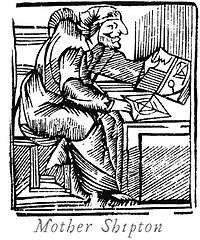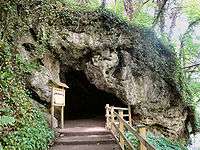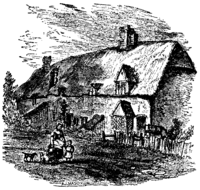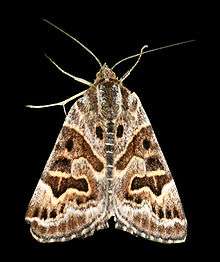Mother Shipton
Ursula Southeil (c. 1488–1561) (also variously spelt as Ursula Southill, Ursula Soothtell[1] or Ursula Sontheil[2][3]), better known as Mother Shipton, is said to have been an English soothsayer and prophetess.


She has sometimes been described as a witch and was associated with folklore about the origin of the Rollright Stones of Oxfordshire, reportedly a king and his men transformed to stone after failing her test. William Camden reported an account of this in a rhyming version in 1610.[4][5]
The first known edition of her prophecies was printed in 1641, eighty years after her reported death. This timing suggests that what was published was a legendary or mythic account. It contained numerous mainly regional predictions, but only two prophetic verses – neither foretold the end of the world. But her reputation and stories about her recounted that she did make such prophecy.[6]
One of the most notable editions of her prophecies was published in 1684.[6] It gave her birthplace as Knaresborough, Yorkshire, in a cave now known as Mother Shipton's Cave. Along with the Petrifying Well and associated parkland, this property is now operated privately as a visitor attraction. She was reputed to be hideously ugly. The book said that she married Toby Shipton, a local carpenter, near York in 1512, and told fortunes and made predictions throughout her life.
Samuel Pepys recorded in his diaries that, whilst surveying the damage to London caused by the 1666 Great Fire in the company of the Royal Family, he heard them discuss Mother Shipton's prophecy of the event.[7]
Prophecies

The most famous claimed edition of Mother Shipton's prophecies foretells many modern events and phenomena. Widely quoted today as if it were the original, it contains over a hundred prophetic rhymed couplets. But the language is notably non-16th-century. This edition includes the now-famous lines:
The world to an end shall come
In eighteen hundred and eighty one.[8]
This version was not published until 1862. More than a decade later, its true author, Charles Hindley, admitted in print that he had created the manuscript.[9]
This fictional prophecy was published over the years with different dates and in (or about) several countries. The booklet The Life and Prophecies of Ursula Sontheil better known as Mother Shipton (1920s, and repeatedly reprinted)[10] predicted the world would end in 1991.[11][12] (In the late 1970s, many news articles were published about Mother Shipton and her prophecy that the world would end - these accounts said it would occur in 1981).
Among other well-known lines from Hindley's fictional version (often quoted as if they were original) are:
A Carriage without a horse shall go;
Disaster fill the world with woe...
In water iron then shall float,
As easy as a wooden boat.[8]
Legacy

The figure of Mother Shipton accumulated considerable folklore and legendary status. Her name became associated with many tragic events and strange goings-on recorded in the UK, North America, and Australia throughout the 17th, 18th, and 19th centuries. Many fortune tellers used her effigy and statue, presumably for purposes of association marketing. Many English pubs were named after her. Only two survive, one near her purported birthplace in Knaresborough and the other in Portsmouth. The latter has a statue of her above the door.
A caricature of Mother Shipton was used in early pantomime. Historians believe this figure may have been the forerunner of the Panto dame.
The Mother Shipton moth (Callistege mi) is named after her. Each wing's pattern resembles a hag's head in profile.
A fundraising campaign was started in 2013 to raise £35,000 to erect a statue of Shipton in Knaresborough. Completed in October 2017, the statue sits on a bench in the town's Market Square close to a statue of John Metcalf, an 18th-century road engineer known as Blind Jack.[13]
Mother Shipton is referred to in Daniel Defoe's Journal of the Plague Year (1772), referring to the year 1665, when the bubonic plague erupted in London:
"These terrors and apprehensions of the people led them into a thousand weak, foolish, and wicked things, which they wanted not a sort of people really wicked to encourage them to: and this was running about to fortune-tellers, cunning-men, and astrologers to know their fortune, or, as it is vulgarly expressed, to have their fortunes told them, their nativities calculated, and the like.... And this trade grew so open and so generally practised that it became common to have signs and inscriptions set up at doors: 'Here lives a fortune-teller', 'Here lives an astrologer', 'Here you may have your nativity calculated', and the like; and Friar Bacon's brazen-head, which was the usual sign of these people's dwellings, was to be seen almost in every street, or else the sign of Mother Shipton...."[14]
See also
- 2012 Doomsday prediction
References
- The Strange and Wonderful History of Mother Shipton, London, 1686
- "Ursula Sontheil (1488-1561)". History and Women. 8 May 2010. Retrieved 6 September 2012.
- "The Life and Prophecies of URSULA SONTHEIL Better Known as MOTHER SHIPTON . Knaresborough, Yorkshire: Amazon.co.uk: J.C. Simpson: Books". Amazon.co.uk. 2 January 2011. Retrieved 6 September 2012.
- "William Camden", Encyclopedia Britannia.
- Anon. "Rollright Stones". BBC: Where I live: Oxford. BBC. Retrieved 19 June 2009.
- Mother Shipton's Prophecies (Mann, 1989)
- Entry for 20 October 1666, cited in Mother Shipton's Prophecies (Mann, 1989)
- Harrison, William Henry (1881). Mother Shipton investigated. The result of critical examination in the British Museum Library, of the literature relating to the Yorkshire sibyl. London.
- Notes and Queries, 26 April 1873
- "The Life and Prophecies of URSULA SONTHEIL Better Known as MOTHER SHIPTON: Books". Amazon.co.uk. Retrieved 6 September 2012.
- Simpson, J. C. (24 August 2017). "The Life and Prophecies of URSULA SONTHEIL Better Known as MOTHER SHIPTON ". The Waverley Press – via Amazon.
- "12 failed end of the world predictions, for 1990 to 1994". Religioustolerance.org. 3 November 1993. Retrieved 6 September 2012.
- "Knaresborough campaign for Mother Shipton statue". BBC News. 3 October 2013. Retrieved 9 November 2013.
- A Journal of the Plague Year (1772), Daniel Defoe, The Project Gutenberg EBook, 2006
External links


- Mother Shipton's Cave and Dropping Well
- Mother Shipton, Her Life and Prophecies, Mysterious Britain & Ireland